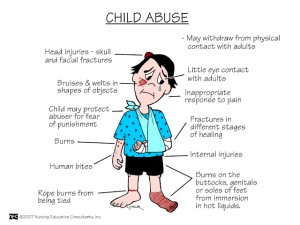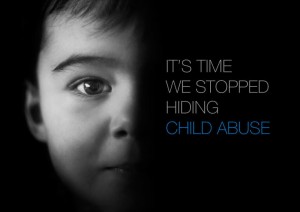The first step in helping abused or neglected children is learning to recognize the signs of child abuse and neglect. The presence of a single sign does not mean that child maltreatment is occurring in a family, but a closer look at the situation may be warranted when  these signs appear repeatedly or in combination.
these signs appear repeatedly or in combination.
The following signs may signal the presence of child physical abuse.
The Child:
- Has unexplained burns, bites, bruises, broken bones or black eyes
- Has fading bruises or other marks noticeable after an absence from school
- Seems frightened of the parents and protests or cries when it is time to go home
- Shrinks at the approach of adults
- Reports injury by a parent or another adult caregiver
- Abuses animals or pets
The Parent or other adult Caregiver:
- Offers conflicting, unconvincing or no explanation for the child’s injury, or provides an explanation that is not consistent with the injury
- Describes the child as “evil” or in some other very negative way
- Uses harsh physical discipline with the child
- Has a history of abusing animals or pets
 The above list may not be all the signs of physical abuse. It is important to pay attention to other behaviors that may seem unusual or concerning.
The above list may not be all the signs of physical abuse. It is important to pay attention to other behaviors that may seem unusual or concerning.
Physical Abuse vs. Discipline
In physical abuse, unlike physical forms of discipline, the following elements are present:
- Unpredictability. The child never knows what is going to set the parent off. There are no clear boundaries or rules. The child is constantly walking on eggshells, never sure what behavior will trigger a physical assault.
- Lashing out in anger. Physically abusive parents act out of anger and the desire to assert control, not the motivation to lovingly teach the child. The angrier the parent, the more intense the abuse.
- Using fear to control behavior. Parents who are physically abusive may believe that their children need to fear them in order to behave, so they use physical abuse to “keep their child in line.” However, what children are really learning is how to avoid being hit, not how to behave or grow as individuals.